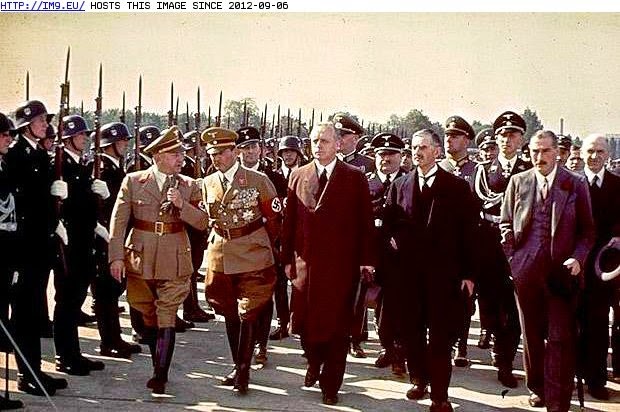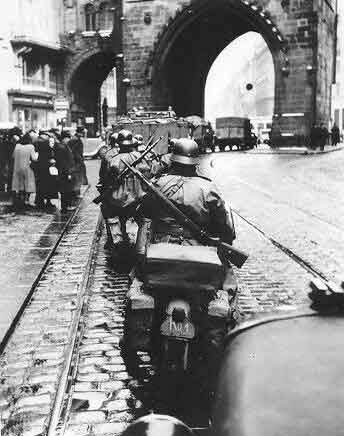It Wasn't Just Germany That Took Over Czechoslovakia
 |
| Sudeten German Freikorps, enjoying food and flowers given to them by locals after the takeover |
On September 30, 1938, in Munich, British Prime Minister Chamberlain, French Premier Daladier, Italian Duce Mussolini, and German Chancellor Adolf Hitler signed the Munich Agreement aka Munich Pact.
 |
| British Prime Minister Neville Chamberlain (1869 - 1940) (front row, second right) walks with past an honor guard at his reception upon arriving at Oberwiesenfeld airport on the way to a meeting with Adolf Hitler over the latter's threats to invade Czechoslovakia, September 28, 1938. Pictured are, from left, German politician Gauleiter Adolf Wagner (1890 - 1944), German SA-Obergruppenführer Franz Ritter von Epp (1868 - 1947), German Foreign Minister Joachim von Ribbentrop (1893 - 1946), Chamberlain, and British Ambassador to Germany Sir Neville Henderson (1882 - 1942). |
It was a very controversial decision and the image of Chamberlain claiming afterward that it meant peace is one of the enduring moments of the 1930s. This agreement legitimized the division of Czechoslovakia. By doing so, it induced Hitler to believe that the Western Powers were weak and unable or simply unwilling to oppose his military ventures. This led him to continue his invasions of surrounding countries, which ultimately triggered World War II.
 |
| All smiles as a stake is put through Czechoslovakia's heart. |
Incredibly, Czechoslovakia was not even invited to the meeting. Czechs call the Munich Pact the "Munich betrayal" by France and the United Kingdom because those nations had previously extended defense guarantees to Czechoslovakia, which obviously they never honored.
The Sudetenland - a newly coined word for the area to be given to Germany - was claimed by the Germans on the basis of the many ethnic Germans living there. This also happened to be the region in which Czechoslovakia had most of its fixed defenses, which were patterned after the fixed Maginot Line of France. Without those defenses, it was powerless against German aggression.
The local Germans in the Sudetenland wanted Germany to come and take them over because they had little in common with the rest of the country's inhabitants. They manufactured crises which made them appear to be victims of the Czech authorities. These enabled Hitler to claim that the Sudeten Germans were being terrorized and slaughtered, though of course, it wasn't clear why the Czechs would do that, especially suddenly, out of the blue. It is generally accepted that these scare stories in the German press were completely fictitious, but it gave Hitler a necessary talking point and pretext for taking aggressive action.
There is an aspect of the Munich pact, however, that has been downplayed ever since World War II. The simple fact is that it wasn't only Germany that dismembered Czechoslovakia. The surrounding nations, seeing a defenseless Czechoslovakia "up for grabs," moved in like vultures to take their shares. Germany didn't really care what happened to other areas of the country, at least at first, and cultivated relations with future war ally Hungary by agreeing in the first "Vienna Award" to their taking over areas adjacent to its own territory. Poland also moved in, and since Germany didn't want to provoke Poland until it was good and ready, it turned a blind eye. There was enough left of Czechoslovakia to go around.
All this left Czechoslovakia as a rump state. Its troops fought the Hungarian (and perhaps Polish) invaders, but resistance was scattered and in any event, they were overwhelmed and received no assistance from England, France or anyone else. Indeed, the Czech people were largely either apathetic or actively supporting the invaders, at least the minorities who were ethnic Germans, Hungarians, and Poles.
Eventually, Germany simply moved in and took over what was left of Czechoslovakia after Poland and Hungary were finished gobbling up their shares, without much fuss. Czechoslovakia knew when it was beaten.
Poland thus annexed Zaolzie, an area with a Polish plurality, over which the two countries had fought a war in 1919 (October 1938).
Hungary occupied border areas (southern third of Slovakia and southern Carpathian Ruthenia) with Hungarian minorities in accordance with the First Vienna Award (November 1938).
On March 15, 1939, during the German invasion of the remaining Czech territories, Hungary annexed Carpathian Ruthenia (which had been autonomous since October 1938).
Germany established the Protectorate of Bohemia and Moravia with a puppet government, on March 16, 1939. This was the now-German territory of pre-war Czechoslovakia. This was what Reinhard Heydrich was given control over before his assassination by Czech partisans in June 1942.
Meanwhile, during the German invasion of Czech territories, a pro-Hitler Catholic-fascist government splits off the remaining territories of Czechoslovakia and declared the Slovak Republic, an Axis client state. This supported Germany throughout World War II.
For many in Central Europe, the Munich Pact was the true beginning of World War II. While everybody regards Poland, for instance, as nothing but a victim of Hitler, it was ready to share in the spoils he offered when it suited their purposes.
Soviet Premier Josef Stalin, watching from the Kremlin, also had a defense pact with Czechoslovakia, but he was pointedly ignored. He viewed the British and French agreement as an indication that they would not honor any treaties and would sell the Soviet Union down the river, too. The Munich Pact was a key milestone on his ultimate decision to reach a non-Aggression Pact with Germany in August 1939, which led directly to his and Hitler's invasion of Poland. That marked the traditional beginning of World War II.
The pictures below show the occupation of Czechoslovakia, not only by Germany but by the other interested parties, Poland and Hungary.
 |
| Tanks of the Hungarian occupation forces enter into the streets of the Czechoslovak city Hust (now part of the Carpathian region of Ukraine). |
 |
| Polish and Hungarian officers shake hands in Czechoslovakia. |
 |
| Locals give flowers to Hungarian soldiers. |
 |
| Ruler (regent) of the Hungarian kingdom, Admiral Miklos Horthy (on a white horse) led a parade of Hungarian troops in occupied Czechoslovakia city Kosice. |
 |
| Polish troops enter the Czechoslovak city Tesín. |
 |
| A Czech line of bunker fortifications in the Sudetenland, known as the "Benes" line - Czechoslovakia's version of the Maginot Line. |
 |
| Funeral for Carpathian Czechoslovak troops and soldiers who died in battle with the Hungarian troops who invaded Czechoslovakia. |
 |
| Residents of the Czech town of Ash welcome German troops. |
 |
| Ruler (regent) of the Hungarian kingdom, Admiral Miklos Horthy (on a white horse) led the parade of Hungarian troops in occupied Czechoslovakia Kosice after its occupation by November 2, 1938. |
 |
| Hungarian and Polish soldiers embrace during their occupation of Czechoslovakia. |
 |
| Admiral Miklos Horthy visits a hospital of soldiers wounded in battle against the defenders of Carpatho-Ukraine. |
 |
| Funeral for Carpathian Czechoslovak troops and soldiers who died in battle with the Hungarian troops who invaded Czechoslovakia. |
 |
| On October 25, 1938, the Prague government dissolved political parties. Dismissing all political parties, Prime Minister autonomous Carpathian Ukraine Augustine Voloshin gave permission "to establish a political party called" Ukrainian national unity "(DNA)" which violated the decision of the Prague authorities. |
 |
| A Czechoslovak soldier kisses his daughter before leaving to fight. |
 |
| American restaurateur Fred Horak, ethnic and Czech native of Prague, at the window of his dining room. |
 |
| A column of captured Czechoslovak tank LT vz. 35 being sent to Germany. |
 |
| Bridge over the River Odra (Oder), where German troops are entering the Czech city of Ostrava 15 March 1939 |
 |
| Germans occupy Prague, 15.03.1939. |
 |
| Polish armor occupies the Czechoslovak village Jorg. |
 |
| Polish soldiers at the Czech border station in Bogumin. |
 |
| German officers watching the capture of Bogumin by Polish troops. |
 |
| A monument to the first president of Czechoslovakia, Tomas Masaryk, in Bogumin. It was broken, during "Operation Zaluzha," the Polish occupation of its portion of Czechoslovakia. |
 |
| The same |
 |
| Polish troops occupy the Czech city Carwin. |
 |
| Polish troops substitute out the Czech name for the Polish name of the city on the railway station of the city Tesín. |
 |
| Residents of Tesin tear down the Czechoslovak border post. |
 |
| The same. |
 |
| Polish soldiers in the post office in the Czech village Ligotka cameral. |
 |
| German column goosesteps in Prague, capital of Czechoslovakia, as pro-German Slovaks extend their arms in the Hitler salute, 1939. Slovakia was a "co-combatant" of Germany under a collaborationist regime. |
 |
| Occupation of Czechoslovakian territories by the German Wehrmacht after the Munich Agreement on 30 September 1938. The National Socialist propaganda text on 2 October 1938: 'The invasion of the German troops in Sudetenland. The youth of Hainspach held on tirelessly; over and over they welcomed the German soldiers with enthusiastic cheers.' Photo: Berliner Verlag/Archiv |
 |
| Polish tanks enter the Czech city Tesín, October 1938. |
 |
| Handshake between Polish Marshal Edward Rydz-Smigly and German attache, Major-General von Studnitz Bogislava at the "Independence Day" Parade in Warsaw November 11, 1938. They would be fighting each other less than a year later. |
 |
| Polish tank breaks through Czechoslovak border fortifications. |
 |
| Part of the Polish 10th Infantry Regiment equestrian 10th Mechanized Brigade preparing for solemn parade before the commander of the regiment at the end of the operation "Zaluzha." |
 |
| Soldiers of the Czechoslovak border detachment ("State Protection Groups), battalion number 24, at the Maria Valeria bridge over the Danube in Parkano (current Stúrovo) in southern Slovakia. They are prepared to repel Hungarian aggression. |
 |
| Burned during the fighting in the night from 21 to 22 September 1938, this is the customs building in the Czechoslovak village Granite. |
 |
| Sudeten Germans tear down the Czechoslovak border post. |
 |
| German Colonel-General von Brauchitsch oversees a parade to celebrate the annexation of the Sudetenland to Germany. |
 |
| Late 1930's. German, Austrian and Czechoslovakian children of Jewish descent were permitted to leave their countries and families on the Kindertransport; a train bound for Britain. These children ranged in age from infant to 17 and were placed with families in Britain. Many never saw their parents again. Sir Nicholas Winton helped save 669 children from Czechoslovakia. |
 |
| Adolf Hitler looks out over Prague. |
2020











































Not much of a tragedy, Czechoslovakia was simply bound to break up at some point and was quit lucky with the Soviets taking care of its "problematic minorities".
ReplyDeleteCzechoslovakia was the creation of the so called, 'Versailles Peace Treaty' an unlawful Criminal undertaking by the French and the Bloody Brits! The thousand years old Kingdome of Hungary was torn apart, so that, 'Little Hungary' was surrounded by Hungarians, from Austria, Czechoslovakia, Soviet Union, Rumania, Yugoslavia! 60% of the territory and 40% of the Hungarian population was ripped out of the 'Thousand Years' old Motherland! The Versailles 'Peace Treaty' had the 'bloody seeds' of WW2 in it! That 'Peace Treaty' in fact was/IS a Crime Against Humanity! The E.U. must rectify that immense 'Criminal Undertaking'!!
ReplyDelete